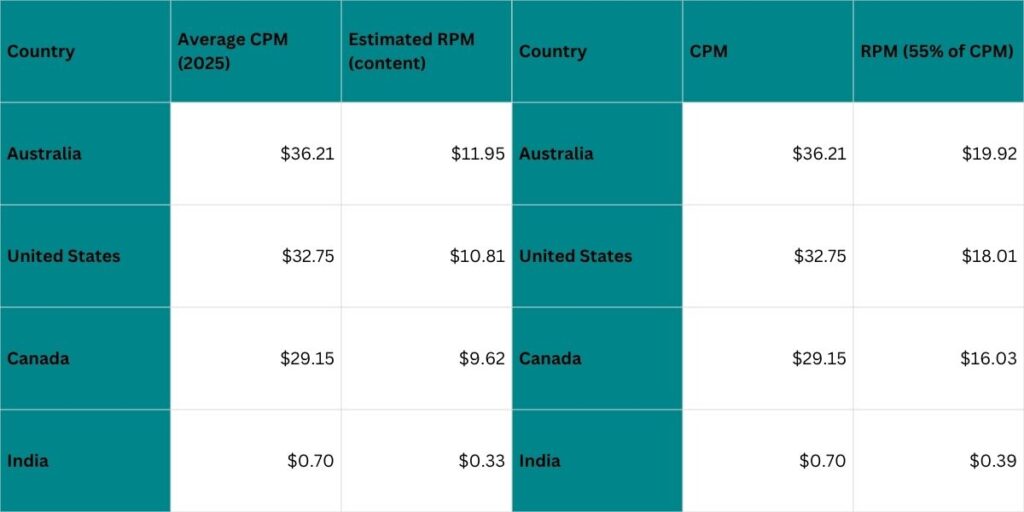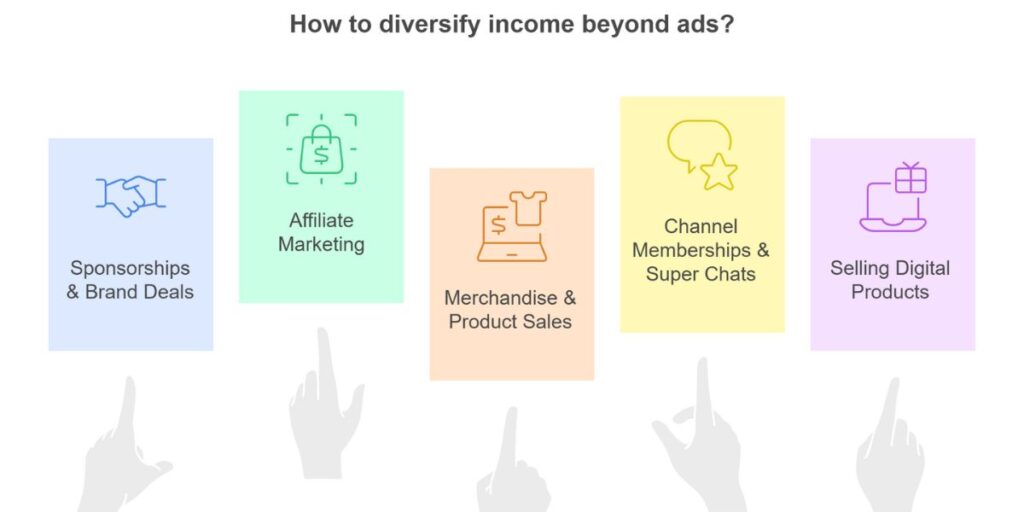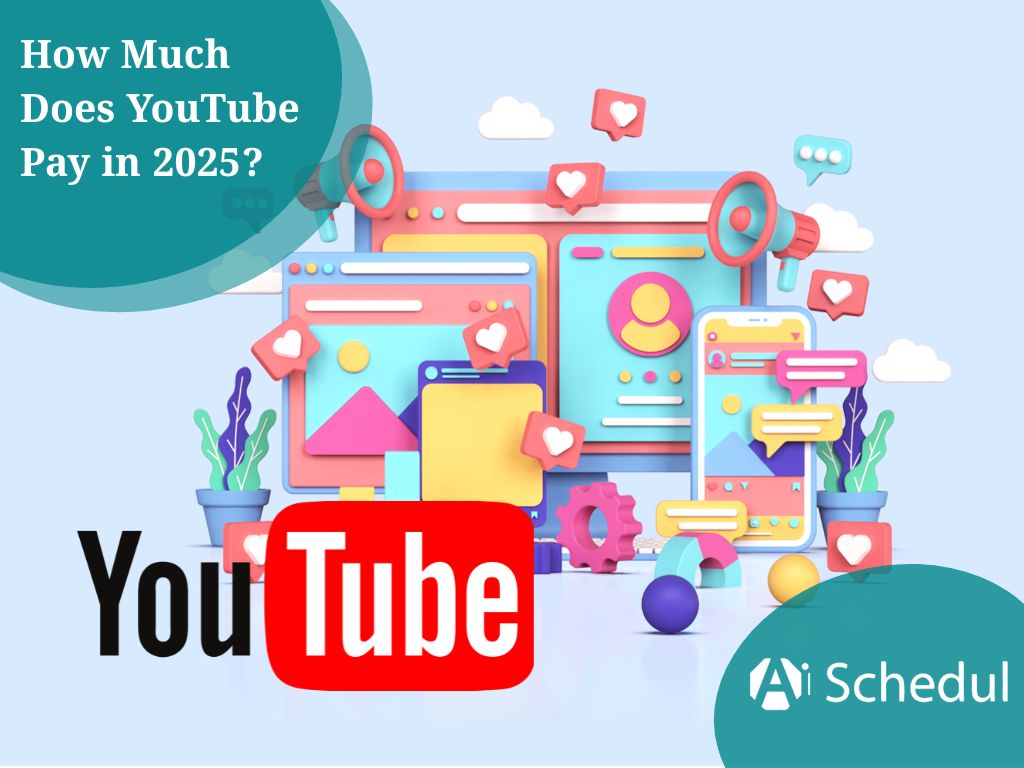Have you ever been curious about YouTube payments to creators in 2025? You may be surprised to learn the number!
In between, how much does an average YouTuber earn per view? Roughly $0.018 per view, or $18 per 1000 views. Do you ever think about how much money a YouTuber makes in a year? We’ll answer all of your questions here!
In this article, we are going to discuss the actual revenues from YouTube and discuss how much you can expect to earn as a content creator in 2025!
Table of Contents
ToggleHow Much Does YouTube Pay Per View in 2025?
When looking at figures regarding the income creators can make in 2025, YouTube is pretty much the same way to pay as you think.
I would like to share exactly what creators earn, and two examples to help understand the differences in earnings.
Average Earnings Per 1,000 Views
According to new data, YouTubers earn between $0.002 and $0.025 for each view they receive in ad revenue. This means the average YouTube per 1,000 views estimated earnings of $1.00 – $25.00 in 2025 (typical low to average high earnings)
However, that can change a lot depending on various factors. Under the standard YouTube revenue split, creators receive 55% of all revenue created from advertising, while YouTube keeps the other 45% of the advertising revenue.
For U.S. creators, this average after YouTube earnings cut is approximately $8.43 per 1,000 views. However, earnings vary widely by country.
Australia has the highest rates right now, at an average CPM of $36.21, followed closely by the United States at $32.75 and Canada at $29.15.
As you can imagine, there are countries like India ($0.70), Indonesia ($0.74), and the Philippines ($0.48) that earn much less.
| Country | Average CPM (2025) | Estimated RPM |
| Australia | $36.21 | $11.95 |
| United States | $32.75 | $10.81 |
| Canada | $29.15 | $9.62 |
| India | $0.70 | $0.33 |
Wondering how much YouTubers make? Your audience’s location makes a tremendous difference!
How Much Does YouTube Pay for 1 Million Views?
The YouTube payout for 1 million views can vary remarkably. The numbers move from $2,000 to $25,000 for views, depending on niche and audience.
For 1 million views, the average payout would be predicted somewhere between $5,000 $7,000 or more, depending on the niche within YouTube, while there are niches where many make up to $30,000.
Other sources say the average is $1,000 to $5,000, while another source says the average of about $15,000.
As far as $1 billion, if you take for granted that your total views made ad revenue, then it is probable to assume that you would get around $ 2 million in ad revenue.
YouTube Income Per 1,000 Views: CPM vs RPM

Knowing the differences between CPM and RPM is crucial for a realistic assessment of potential income.
- CPM (cost per mille) refers to what advertisers pay Upwork for every 1,000 impressions.
- RPM refers to what Creators actually make after YouTube takes its cut, roughly 45% of ad revenue.
This means if CPM is $10, RPM may only be roughly $5. There really isn’t a better way to pool rates that is clearer than RPM.
Rates vary by niche:
- Finance $15-$50
- Tech $5 -$30
- Education $10-$25
- Ggaming $4-$15
YouTube typically pays more than TikTok, Pinterest, etc., for more CPM and RPM for those maintaining similar views, to be fair.
Keep in mind that not every view will be monetized. Ad blockers, as well as YouTube Premium users, lower CPM and therefore lower RPM rates.
Early viewers will also cut into ad revenue. Therefore, monetized playbacks will be much more important, along with keeping track of RPM over a period of time.
What Affects How Much YouTube Pays?
In 2025, YouTube pays content creators based on several major factors. Knowing these factors will help you to get the most out of your earnings on YouTube!
Niche & Advertiser Demand
The niche of your content drastically affects your YouTube revenue. For example, finance channels earn a staggering $12.00 – $25.00 per CPM because banking and investing institutions are clamoring for that viewership.
Alternatively, gaming channels will average as low as $1.40 CPM despite being one of the most popular niches. Here are some additional valuable niches:
- Digital marketing ($12.52 CPM)
- Personal finance ($12.00 CPM)
- Education ($9.89 CPM)
- Tech reviews ($7.31 CPM)
Lifestyle creators tend to earn around $3.47 CPM on their videos, while travel niche content comes in at an average of $2.00 CPM.
If you want to learn how to make money off YouTube videos, high-value niches can boost your earnings potential by 3x!
Audience Location & Demographics
The location of your audience significantly impacts how much YouTube compensates for views. The top CPM countries to look out for in 2025 will be:
| Country | Average CPM |
| Australia | $36.21 |
| United States | $32.75 |
| Canada | $29.15 |
| United Kingdom | $21.59 |
Additionally, viewers aged 35-44 generate around $6.50 revenue for every 1,000 views, while the 18-24 age group creates only $4.50.
Video Length & Watch Time
Longer videos generally generate more income because they can have more placements for advertisements. Normally, videos over 8 minutes allow for mid-roll ads, which greatly increases revenue potential. For maximum monetization:
- Create videos at least 8 minutes long for mid-roll ad eligibility
- Place ads at natural content breaks to reduce viewer drop-off
- Balance ad frequency—too many interruptions can hurt retention
Are you instead wondering how to make money on Instagram? Generally, YouTube has better monetization opportunities available than segments that run longer.
Ad Types & Placements
Different ad formats have different revenue. When you enable monetization, YouTube offers several ad types:
- Skippable video ads, which viewers can skip after 5 seconds.
- Non-skippable ads, which last 15–20 seconds (up to 30 seconds for TV).
- Bumper ads, which last for 6 seconds (and are unskippable).
- YouTube shorts ads, which are swipeable in between shorts. (learn how to get more views on YouTube Shorts so you can earn more money from ads)
- Pre-roll and mid-roll ad placements commonly perform better than post-roll ads.
Recently, YouTube made it easier for creators when turning on ads for long-form videos; YouTube automatically shows relevant ad types. How much does Instagram pay for the same? Generally, YouTube has a wider range of ad types available.
YouTube Premium & Ad Blockers
YouTube Premium subscribers are not shown ads, but creators still get paid. Revenue from premium members is allocated based on how long they watch your videos.
In fact, YouTube pays creators 55% of premium subscriptions allocated to creators based on how long premium members watch their videos.
Another important point is that, in general, 27% of internet users use ad blockers, and 11% of those users are specifically blocking YouTube ads. This can impact revenue on potential income, since you can’t earn any income based on ads that are blocked.
However, downloads and background play from premium members still count towards increasing your watch time and subsequent earnings.
So if you want to find out how to make money as an influencer aside from ad revenue, see what we suggest.
How Much Do YouTubers Make at Different Levels?

YouTuber income varies greatly depending on the number of subscribers. Let’s take a look at actual income at each creator level in the year 2025.
Small Creators (1,000–10,000 Subscribers)
For new creators who have crossed the 1,000-subscriber mark, they might be seeing earnings anywhere from $20-$50/month from purely ad revenue.
Creators that combine courses and affiliate marketing in addition to ad revenue can see $200-$500+ even at this early stage. Creators that are in high-CPM content niches like finance or technology can see talk of earnings being in the $200-$500+ range still even at that stage.
Smaller YouTubers often report that the money starts to get more meaningful once they start to regularly see 20,000+ monthly views.
Mid-tier Creators (10,000–100,000 Subscribers)
After you build up your first 10,000 followers, you’ll likely begin to see around $500 – $1,000 in revenue each month.
When you can start creating longer videos (10+ mins), utilize mid-roll ads, which are more productive, as channels tend to grow faster. Mid-tier creators make anywhere from $1,000 – $10,000 per month with an average of 100,000 views per month.
Today, sponsorships are much easier to get, earning anywhere from $30 – $70 per 1,000 views.
Large Creators (100,000+ Subscribers)
Once you achieve 100,000 subscribers, you’ve reached professional creator status. You can expect to earn between $2,000-$5,000/month+, but it depends on your niche & audience demographics.
With sponsorships, channels in this range could be generating $10,000-$30,000+ per month.
One creator with 200,000 subscribers shared that they made $350,000 per year with different income streams on YouTube, for example.
Up until this point, we have focused on AdSense, but creators with large audience growth focus on different ways to monetize their channels, like channel memberships, creating products, and Super Chat during live streams!
How Much Does YouTube Pay Per Subscriber?
The reality is, YouTube does not compensate you for each subscriber you acquire whatsoever.
Your earnings aren’t based on how many subscribers you have, but instead solely on how many views and how engaged your viewers are. Nonetheless, subscribers do have merit because they:
| Subscriber Level | Estimated Monthly Value Per Sub |
| Small channels | $0.01-$0.05 per subscriber |
| Mid-tier | $0.10-$0.50 per subscriber |
| Top-tier | $1.00+ per subscriber |
How to Increase Your YouTube Earnings
Want to boost your YouTube revenue in 2025? Let’s explore proven strategies that can significantly increase your earnings potential.
Create Longer, Engaging Videos
Videos that exceed 8 minutes open up a huge monetization avenue, a highly sought-after advantage of mid-roll ads.
A video configuration range from eight to fifteen minutes is usually the sweet spot for maximizing income while maintaining viewer engagement.
First, and most importantly, longer videos allow you to place more ads into the video, which opens up earning potential. According to research, over fifteen-minute videos lead to 50% of audience engagement, with only eight percent of all videos created.
Use Mid-Roll Ads Effectively
On the whole, mid-roll ads have a 75% completion rate compared to pre-roll (61%) and post-roll (46%). For optimal placement:
- Position ads at natural breakpoints or transitions
- YouTube’s system marks poor placements in red
- Balance ad frequency—too many interruptions hurt retention
More specifically, Google’s automatic placement uses the power of machine learning to find the ideal spots to insert ads.
In fact, keep in mind that any mid-roll offers a possible drop-off point, so placement of cards is of utmost importance.
Focus on High-Paying Niches
Finance channels command $12-$25 CPM rates because banks and investment platforms eagerly pursue this audience. Other profitable niches include:
| Niche | Average CPM (2025) |
| Luxury lifestyle | $16-$20 |
| Digital marketing | $12.52 |
| Education | $9.89 |
| Tech reviews | $7.31 |
Boost Viewer Retention & Engagement
Strong audience retention directly increases earnings. In addition to creating quality content, try these proven retention strategies:
- Hook viewers within 15 seconds with compelling openings
- Use “pattern interrupts” like animations, graphics, or scene changes
- Draft video chapters to aid in navigation
- Use interesting visuals and on-screen graphics.
To maximize engagement, keep in mind that videos with high retention rank higher and garner significantly more income with the same number of views.
Optimize for Shorts & Mobile Viewers
Over 90% of YouTube views come from mobile devices, making optimization critical. Vertical formats perform exceptionally well as they fill the entire smartphone screen. To enhance mobile viewing:
- Create YouTube Shorts (vertical 9:16 ratio)
- Add captions for viewers watching without sound
- Use larger text in thumbnails and on-screen graphics
- Keep important visual elements centered
How Much Does YouTube Pay for Shorts?
YouTube Shorts monetizes slightly differently than regular videos.
Creators get 45% of the total ad revenue earned from Shorts, with or without music. RPM for Shorts generally runs from 1¢ to 6¢ but varies by country:
- United States: $0.33 RPM
- Switzerland: $0.20 RPM
- Australia: $0.19 RPM
Beyond Ads: Other Ways YouTubers Make Money

Beyond basic ad revenue, savvy content creators tap into multiple income streams to maximize their YouTube earnings.
Even if you are wondering how to make money on TikTok, you can use some of these plans to boost your earnings.
Sponsorships & Brand Deals
For most YouTubers, their biggest source of revenue comes from brand sponsorships.
A creator generating about 50,000-250,000 views per video can normally command around $25 CPM.
That can translate into potential earnings of $1,250-$6,250 for one sponsorship. Even smaller creators generating about 5,000-10000 views can often generate a CPM of $50-$100.
Oftentimes, creators will calculate sponsorship rates based on total audience reach across all platforms. In highly desirable niches such as finance or technology, sponsorships can increase even higher.
Affiliate Marketing
Many creators make money through affiliate programs by earning a commission whenever one of their viewers purchases a product through their custom affiliate links.
This works particularly well for product review and tutorial channels. Affiliate marketing is different from monetization because it doesn’t require a creator to be a YouTube Partner Program (YPP) member.
YouTube very recently launched its Shopping affiliate program for creators with more than 10,000 subscribers, so they can tag products directly into videos. Each retailer offers different commission rates, and payment can take anywhere from 60-120 days.
Merchandise & Product Sales
Custom merchandise provides substantial income while strengthening fan connections. Popular merch items include:
| Product Type | Popularity | Profit Margin |
| Hoodies/Sweatshirts | 70% | Medium-High |
| T-shirts | 50% | Medium |
| Stickers | 33% | High |
Print-on-demand services like Printify eliminate inventory concerns. Scott Walter reports that merchandise generates up to 50% of his total revenue.
Channel Memberships & Super Chats
Creators can offer tiered membership subscriptions with exclusive perks to fans after they reach 500+ subscribers.
YouTube takes 30% of the membership fee. Super Chats work similarly and allow viewers to pay to “bump” their comment (to highlight it) during a live stream, with creators earning 70% of the donation.
Many creators report that these features help contribute 30-45% of total earnings from their channel.
Selling Digital Products or Services
Producing and selling digital goods such as templates, guides, courses, or presets simply creates passive income generation without ongoing production costs added.
Using Shopify (starting as low as $5/month) gives creators a way to sell directly through their YouTube content. For educational channels, specific online courses could produce significant revenue streams.
YouTube Monetization
There is still very good money to be made with YouTube monetization in 2025, approximately $2 – $25 per 1,000 views. The most important consideration again is the niche.
Other factors that contribute include where your audience is from (best performing = US, Australia, etc.), better engagement, and posting longer videos in general.
Creators monetize more heavily with brand deals, affiliate sales, merch, and digital products, so do not expect to only rely on AdSense. It takes time and consistency to build a revenue stream.
FAQs about YouTube Earnings
- How much money does a YouTuber make annually?
The typical compensation for content creators in the United States is approximately $120,226 per year.
- What factors influence YouTube earnings the most?
The most significant factors affecting YouTube earnings are content niche, audience location and demographics, video length, and engagement rates.
- Does YouTube pay monthly?
Certainly, all of the earnings from the month will register, and once payout time arrives, AdSense will pay the creator the accrued amount. Please, check your AdSense dashboard for actual payout dates, minimum payment thresholds, and verification status.
- How many views count as “viral”?
There is no set metric; a lot of things play into determining virality, including the platform, speed of engagement, and overall engagement are all factors. On YouTube, somewhat over 1M views is generally considered viral.

